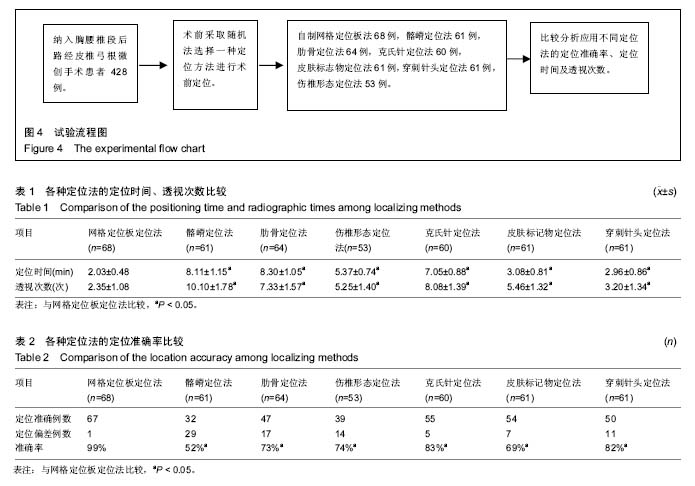| [1] 蔡俊丰,彭庄,祝建光,等.脊柱定位尺在胸腰椎后路手术术前定位中的应用[J].中国脊柱脊髓杂志,2010,20(4):317-321.[2] Hsu W, Sciubba DM, Sasson AD,et al.Intraoperative Localization of Thoracic Spine Level With Preoperative Percutaneous Placement of Intravertebral Polymethylmethacrylate. J Spinal Disord Tech. 2008;21(1):72-75.[3] Gebauer G, Anderson DG. Complications of Minimally Invasive Lumbar Spine Surgery. Spine Surg. 2011;23:114-122.[4] 伍骥,黄蓉蓉. 重视胸腰段脊柱骨折的诊断和治疗[J].中国骨伤, 2015,29(1):1-3.[5] 王华东,史亚民,侯树勋,等.非相邻多节段脊柱骨折的诊断与手术治疗[J].中国脊柱脊髓杂志,2005,15(2):27-30.[6] 谢丽锋. 脊柱外伤磁共振成像CT及数字化X线摄影术诊断价值对比分析[J]. 实用医学影像杂志,2016,17(5):443-444.[7] 穆小平,韦建勋. 胸腰椎骨折手术方式的研究进展[J]. 医学综述, 2016,22(11):2165-2168.[8] 卢镇生,郑建河,叶握球. 椎体后凸成形术治疗骨质疏松性脊柱骨折的中远期疗效分析[J].中国医药科学, 2015,5(10):182- 184.[9] 晏礼,宋文慧,王春强. 胸腰椎骨折分类及治疗研究新进展[J]. 中国矫形外科杂志,2013,21(12):1202-1205.[10] 王洪伟,王许可,李长青,等. 多节段非相邻型脊柱骨折的致伤机制及伤情特点[J]. 中国矫形外科杂志,2013,21(2):132-135.[11] 杨波,谢景开,尹飚,等. 经皮椎体成形术治疗老年多节段骨质疏松性椎体压缩性骨折[J]. 中国矫形外科杂志,2012,20(24): 2212-2216.[12] Cappuccio M , De Iure F , Amendola L, et al. Vertebral body compression fracture after percutaneous pedicle screw removal in a young man. J Orthop Traumatol. 2015;16(4): 343-345.[13] Lefranc M , Peltier J . Accuracy of thoracolumbar transpedicular and vertebral body percutaneous screw placement: coupling the Rosa(®) Spine robot with intraoperative flat-panel CT guidance-a cadaver study. J Robot Surg. 2015;9 (4):331-338.[14] 张德盛,刘树平,刘跃洪,等.纳米羟基磷灰石/聚酰胺66复合生物活性支撑材料对椎体结构和高度的影响[J].中国组织工程研究, 2015,19(43):6977-6982.[15] Donnelly DJ , Abd-El-Barr MM , Lu Y. Minimally Invasive Muscle Sparing Posterior-Only Approach for Lumbar Circumferential Decompression and Stabilization to Treat Spine Metastasis-Technical Report. World Neurosurg. 2015; 84(5):1484-1490.[16] Kwan MK , Chiu CK , Lee CK , et al. Comparison between percutaneous fluoroscopic-guided and conventional open pedicle screw placement techniques for the thoracic spine: a safety evaluation in human cadavers. Bone Joint J. 2015;97-B (11):1555-1561.[17] 杨丰建,林伟龙,朱炯,等.经皮椎体成形术和经皮椎体后凸成形术治疗骨质疏松性椎体压缩骨折[J].中国脊柱脊髓杂志, 2011, 21(1):50-54.[18] 汪东,牛国旗. 经皮椎体成形术及椎体后凸成形术的现状及进展[J].中华全科医学,2014,12(4):625-627.[19] 翟浩瀚,陈艺,龙浩,等. 经皮椎弓根穿刺辅助定位导向装置在经皮椎体成形术中的应用[J].中国骨科临床与基础研究杂志, 2014, 6(4):222-226.[20] 熊伟,向铁城,黄象望,等. 新型经皮椎弓根穿刺简易定位法在椎体成形术中的应用效果[J]. 中国临床研究,2016,29(3):351-353.[21] 刘瑾,陈立启,郭虎兵,等. 腰骶椎框架式经皮椎弓根螺钉置入定位器的研发和应用[J].实用骨科杂志,2015,21(10):897-901.[22] 刘克,李扬彬,唐志伟,等. CT引导下经皮椎弓根置管定位术的探讨[J]. 影像诊断与介入放射学,2004,13(2):117-118.[23] 安月盘.个性化经皮椎体成形术腰椎椎弓根定位模板设计的应用解剖学研究进展[J]. 内蒙古医学杂志,2010,(S6):67-71.[24] 镐英杰,于磊,李志磊,等.经皮椎弓根瞄准器的研制及其临床应用[J].中国矫形外科杂志,2015,23(1):82-85.[25] 刘小勇,杨惠林,唐天驷,等.椎体后凸成形术棘突定位穿刺点与穿刺轨道的研究[J].中华骨科杂志,2005,25(8):462-466.[26] 郭虎兵,刘瑾,谈敬忠,等.腰骶椎经皮椎弓根螺钉相关放射学数据测量及临床意义[J].中国矫形外科杂志, 2015,23(18):1657- 1661.[27] Pishnamaz M, Lichte P, Sellei RM, et al. Percutaneous stabilization of the thoracic and lumbar spine with active intraoperative reduction. Oper Orthop Traumatol. 2015;27 (5): 439-447. [28] Nimjee SM , Karikari IO, Carolyn A Hardin AB, et al. Safe and accurate placement of thoracic and thoracolumbar percutaneous pedicle screws without image-navigation. Asian J Neurosurg 2015 ;(4):272-275.[29] Luo P, Ni WF , Wu YS, et al. The surgical management of traumatic lower cervical spondylolisthesis with posterior percutaneous pedicle screw fixation. Asian Spine J. 2015;9 (2): 271-275.[30] 梁德,叶林强,江晓兵,等.骨水泥-椎体体积比及椎体骨壁裂口与经皮椎体成形术骨水泥渗漏的相关性分析[J].中国修复重建外科杂志,2014,28(11):1358-1363.[31] 宋西正,易国良,王文军,等.外固定器整复下经皮椎体成形术治疗伤椎后壁破损的骨质疏松性压缩骨折[J].中国脊柱脊髓杂志, 2011,21(8):659-662.[32] 俞伟杨,何登伟.经皮椎体成形术治疗骨质疏松性椎体压缩骨折的对比研究[J].实用医学杂志,2010,39(22):4110-4111.[33] Paolini S,Ciappetta P,Missori P,et al.Spinous Process Marking:a Reliable Method for Preoperative Surface Localization of Intradural Lesions of the High Thoracic Spine. Br J Neurosurg. 2005;19(1):74-76. [34] Binning MJ, Schmidt MH, Percutaneous Placement of Radiopaque Markers at the Pedicle of Interest for Preoperative Localization of Thoracic Spine Level. Spine. 2010;35(19):1821-1825.[35] Upadhyaya CD,Wu JC,Chin CT,et al.Avoidance of Wrong-level Thoracic Spine Surgery: Intraoperative Localization with Preoperative Percutaneous Fiducial Screw Placement. J Neurosurg Spine. 2012;16(3):280-284.[36] 贺石生,张海龙,顾昕,等.腰椎微创手术术前定位器的设计及临床应用[J].中华骨科杂志,2011,31(10):1170-1171.[37] 任丁,储辉,黄洪,等.胸腰椎微创手术体表定位器的研制及临床应用[J].中国骨与关节损伤,2014,29(9):866-868.[38] 卢政好,欧军,苏小桃,等.微创经皮置钉技术治疗胸腰椎骨折的临床疗效[J] .临床骨科杂志,2016,19(5):518-521.[39] 李瑾,饶海军,唐向阳.经皮微创与常规椎弓根螺钉治疗中老年胸腰椎骨折的疗效比较[J] .实用临床医学, 2016,17(6):38-40+55.[40] 李林立,董有海. 经皮椎弓根螺钉内固定术在微创脊柱外科中的应用进展[J]. 骨科,2016,7(3):215-218.[41] Malham GM , Goss B , Blecher C. Percutaneous Pedicle Screw Accuracy with Dynamic Electromyography: The Early Experience of a Traditionally Open Spine Surgeon. J Neurol Surg A Cent Eur Neurosurg.2015;76(4): 303-308. [42] Uluta? M, Seçer M, Çelik SE. Minimallyinvasive mini open split-muscular percutaneouspediclescrew fixation of the thoracolumbar spine. Orthop Rev (Pavia). 2015;7(1): 5661.[43] Park HY, Lee SH, Park SJ, et al. Minimallyinvasive option using percutaneouspediclescrew for instability of metastasis involving thoracolumbar and lumbar spine : a case series in a single center. J Korean Neurosurg Soc. 2015;57(2):100-107.[44] Charles YP,Zairi F,Vincent C,et al.Minimally-invasive posterior surgery for thoracolumbar fractures: new trends to decrease muscle damage. Eur J Orthop Surg Traumatol. 2012;22(1): 1-7.[45] Wild MH, Glees M, Plieschnegger C, et al.Five-year follow-up examination after purely minimally invasive posterior stabilization of thoracolumbar fractures: a comparison of minimally invasive percutaneously and conventionally open treated patients. Arch Orthop Trauma Surg. 2007;127(5): 335-343.[46] Schmidt OI, Strasser S, Kaufmann V, et al. Role of early minimal-invasive spine fixation in acute thoracic and lumbar spine trauma. Indian J Orthop. 2007;41(4):374-380. |
.jpg)

.jpg)
.jpg)
.jpg)